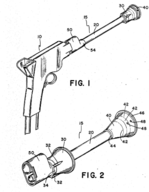SABER: Splash Absorbing Barricade for Exposure Reduction for Wound Irrigation and Debridement
TECHNOLOGY NUMBER: 2019-060

OVERVIEW
A lavage/suction tip to limit contamination during wound debridement and irrigation- Consists of a handpiece with a water jet and a transparent protective cover
- Recovers fluids and debris to optimize personal protection compared to existing methods
BACKGROUND
Wound irrigation and debridement are important aspects of wound care that are carried out to prevent infection and promote healing. Irrigation involves the flushing of an open wound with a fluid saline solution to clean the surface and remove loose debris. The debridement phase of would care includes removal of dead, damaged, or infected tissue with the goal of exposing healthier tissue to promote the healing process. Any of several different methods may be used to try to prevent splashback during wound irrigation and debridement, including the use of personal protective equipment. Further protection can be provided by surrounding the wound with towels or drapes, irrigating the wound with a controlled and steady pressure, and employing a splash shield. Still, even with the stringent use of existing methods, a risk persists that healthcare providers will be exposed to contamination due to splashback during wound irrigation. As such, a need exists for improved methods of shielding during wound irrigation and debridement.
INNOVATION
Researchers have created a lavage/suction tip to provide irrigating fluid to a wound while providing suction to remove fluids and debris away from the surgical site. The handpiece includes a fluid jet with a sealing edge that adapts to the shape of the patient and provides an airtight closure which eliminates splashback. When necessary, the splash shield may be retracted so that the distal end of the tip may be positioned directly against an irrigation site. The pressure line for the water jet opens laterally into the lateral surface close to the handpiece and forms a discharge nozzle there. The protective cover is configured in the form of a funnel in the region of the suction opening to improve the take up of the water separating jet and the separated tissue parts. The cover is made of a transparent material in order to permit viewing into the work chamber from the outside, and therefore onto the work area.